We may earn revenue from the products available on this page and participate in affiliate programs. Learn more ›
You probably know what a home theater is if you clicked on this article. However, on the off chance you stumbled here by accident or are specifically trying to learn more about them, a home theater is basically an audio-video setup that best replicates the movie theater experience at home. The screen is only the first step, and while many people have an excellent 4K or 8K television or projector, plenty of folks never go further into what truly makes a home theater: the sound.
Immersive audio takes a home theater system to the next level. While the built-in sound of television sets is much better than in decades past—with innovative acoustic technologies that bounce sound off your walls and ceiling and analyze echos to build a sound profile mimicing object-based, multi-driver systems—true theater-quality sound is simply not available from the small speakers in a flatscreen or projector. However, that doesn’t mean that there aren’t affordable options that will drastically improve your listening—and, therefore, viewing—experience. Home-theater technology has come far enough that there are affordable options for smaller living rooms and top-of-the-line dedicated theater room technologies with a half-dozen or more speakers set and calibrated just as they would be in a movie theater.
In short, home theaters are upgrades that improve anything you want to do with a screen. Streaming, sports, Blu-rays, video games, or even using your TV as your DJ/karaoke system for a party will be improved if you upgrade to a home theater setup. Once you hear the difference, you’ll never want to return to built-in speakers again. Read on to determine which system fits your needs and living situation.
 When it comes to a custom home theater, one room can require many components. But most rooms start to benefit from a single soundbar. Read on to go in-depth on expansive sound options, big and small. / Tony Ware
When it comes to a custom home theater, one room can require many components. But most rooms start to benefit from a single soundbar. Read on to go in-depth on expansive sound options, big and small. / Tony Ware
How we got to the best home-theater systems
Every product in this guide is recommended. The question isn’t necessarily which setup is the best but which setup is best for you and your particular situation. Product choices came from various reviews and round-ups from our staff, which consisted of field-testing the equipment and assessing user impressions and the consensus of trusted peers.
A short history of home-theater systems
Like many technologies, home theaters started as something only the uber-rich could even dream of owning. Literally, people would just build small movie theaters in their homes if they could afford it. While opulent for the time, the projectors in these screening rooms would be a huge downgrade from even a bargain-price flatscreen TV today. Before the 1970s, film sound was predominantly mono, which means all the sound was on a single audio track, and if multiple speakers were used, they simply played the same track together. Sometimes different frequencies would be emphasized in different speakers to give the illusion of multiple tracks. Recording in stereo was possible, but most theaters simply played a mono version of a stereo recording.
In 1975, Dolby—one of the most important companies in film sound technology history—introduced Dolby Stereo, a method of encoding multiple channels of sound within the same space that was previously used for mono sound. While we think of stereo as two channels—left and right—it’s actually four with Dolby: left, right, center, and ambient. The quality of theater sound improving in the 1970s coincided with the rise of the blockbuster movie (Star Wars was one of the first big Dolby Stereo hits) and just slightly preceded the home video industry, which was born in the early 1980s with the invention of Betamax and the eventual market leader, VHS. With all these technologies in place, plus people’s desire to see more movies more often, a more affordable home theater system—rather than a dedicated screening room—was finally possible.
 Star Wars was one of the first big Dolby Stereo hits / iam_os, Unsplash iam_os, Unsplash
Star Wars was one of the first big Dolby Stereo hits / iam_os, Unsplash iam_os, Unsplash
One of the first companies to market a home theater system was the Crutchfield company, which sold a package that included a 19-inch TV, a VCR, a stereo receiver, a turntable, a video disc player, a cassette player, and speakers integrated into a single piece of cabinet furniture. It may well have been the first all-in-one “home theater” meant to go into a room, not be a room. The price was about $3,400—or $10,000 in 2023 dollars.
Since the 1970s and 1980s, every bit of those home technologies has improved. Dolby Stereo gave way to 5.1-channel Dolby Digital, commonly used on VHS’s replacement technology, DVD. In 2010, the number of discrete channels was upped by two with 7.1-channel Dolby Surround and then improved again with Dolby Atmos, which created the concept of height channels, giving more of a sense of 3D sound. Atmos goes beyond expanding the soundscape to placing sounds, referred to as objects, at precise points in space, giving a better sense of motion to sound traveling through and between different speakers.
Atmos is the current high-water mark for theater and home theater sound, as well as the technology behind Apple Music’s spatial audio, and is a game-changer. “3D sound” is a buzzword more than a technology—sound itself has always been 3D—but Dolby Atmos is the best approximation of what we imagine with “3D sound” yet, allowing the audience to feel like they hear a film or game from within it. Dolby Digital, Dolby Surround, and Dolby Atmos technologies are available on home systems, some streaming content if your Internet connection has enough bandwidth, and Blu-ray discs. Even if you’re listening to built-in speakers on a TV, these technologies vastly improved the sound those systems provide because of the recording technology involved in creating them, but given a multi-channel set-up, near-theater-perfect sound is now available at home as output as well.
Multiple channels, however, means the need for multiple speakers, more and more and more as the technology improves. Or does it? The need for an improved sound experience with a smaller space and number of components requirement was the impetus for the invention of soundbars: multiple speakers housed in a single, wide, low-profile speaker enclosure that is designed to sit right below a flatscreen television. The discrete channels of Dolby Surround or Dolby Atmos are routed to the individual drivers within the bar, which direct them forward, sideways, and upward (bouncing off the ceiling) to produce a deeper sound profile. Soundbars are the space-saving solution to a multiple-speaker set-up, though they won’t truly give you all-around-you sound profiles since the speaker’s physical location is still front-and-center.
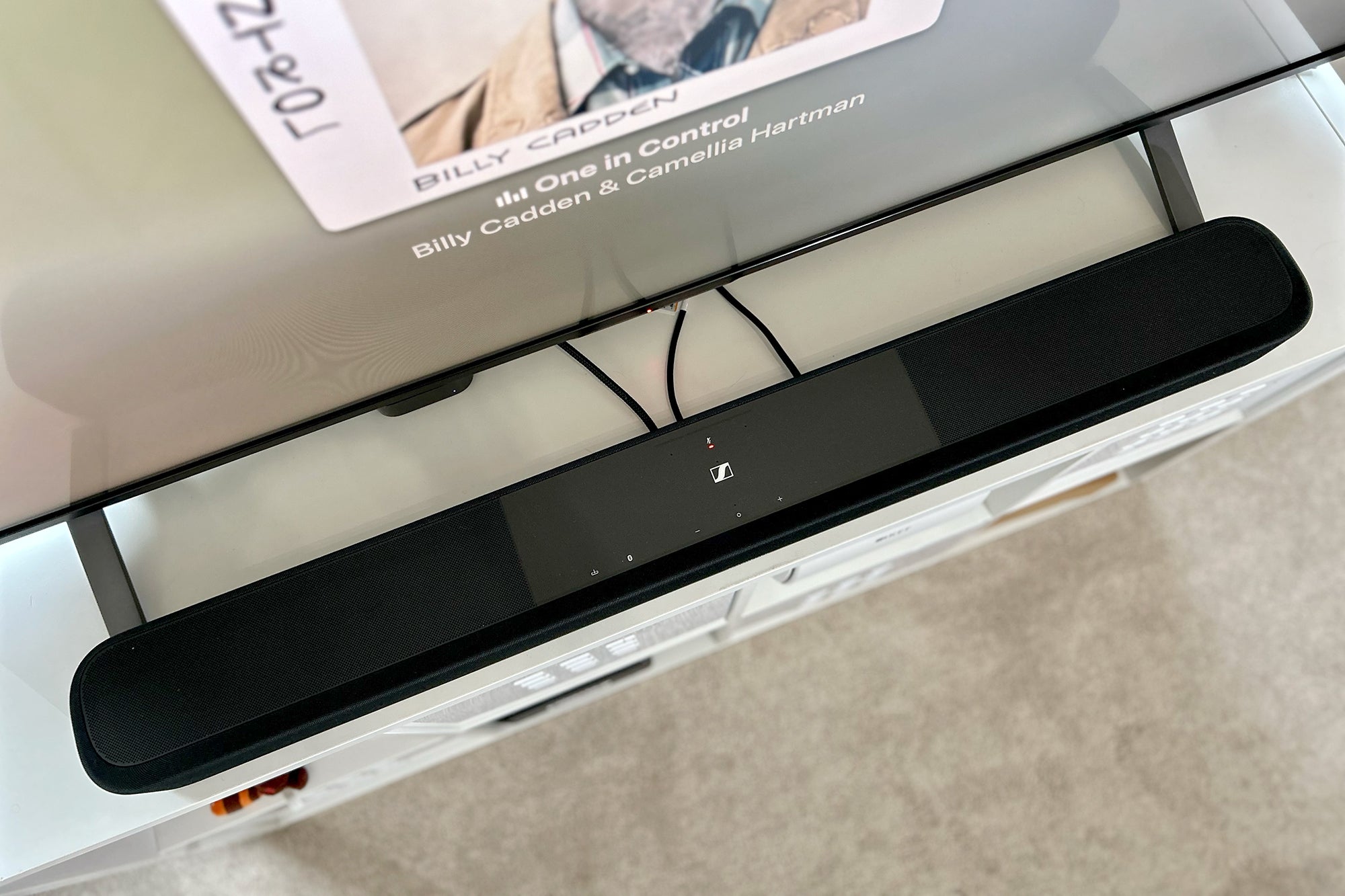 Soundbars help you save space, and can offer some vivid virtualization, but don’t give you a true all-around sound profile. / Tony Ware
Soundbars help you save space, and can offer some vivid virtualization, but don’t give you a true all-around sound profile. / Tony Ware
Those numbers that often describe speaker systems, which might be confusing, are the sound channels that a system supports. Let’s take 7.1.4, for example. The 7 represents seven speakers (or speaker arrays) that playback discrete sources. All or just some can be in use at the same time. Some of these sources may be direct sounds like dialogue or the impact of a punch, and some may be more ambient surround sound like “room tone” or nature sounds. However, the system allows for more depth and breadth in the soundscape by separating these sounds, which previously would have emitted all from the same source or a stereo pair of speakers.
Expanding this first number was the first theater/home theater sound innovation. The second number is the number of subwoofers. A subwoofer is a channel/speaker dedicated to mid-bass to sub-bass, which is often what makes the audience “feel” the sound. It rarely carries discernible dialogue, sound effects, or music, but rather sweetens the “oomph” of the other sound. The last number is unique to Dolby Atmos, as it indicates the number of channels of sound dedicated to sounds directed at different heights. So a 7.1.4 system actually has 13 different sources of sound and at least 13 different speakers (multiple speakers can be used as a single source). In our short history, a simple explanation of the numbers is that mono sound would be considered 1.0, stereo 2.0 (and later 2.1, if a subwoofer were added for bass), and “surround sound” as we know it starts at 5.0, as channels that are meant to be heard behind the listener are added.
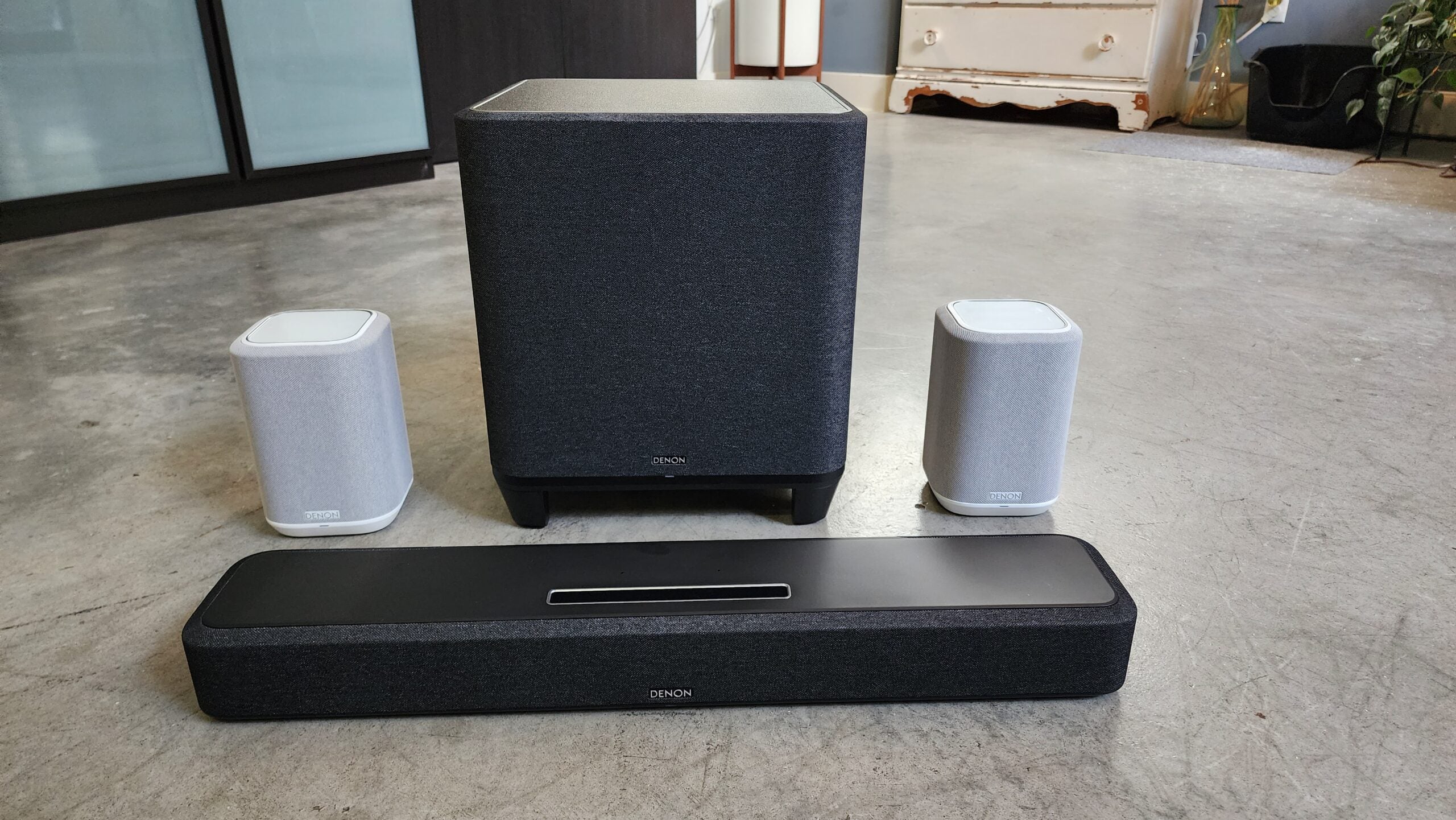 A subwoofer (the big square in the back middle) helps you “feel” the sound thanks to its dedication to mid- and sub-bass. / Markkus Rovito
A subwoofer (the big square in the back middle) helps you “feel” the sound thanks to its dedication to mid- and sub-bass. / Markkus Rovito
Do I even need a home-theater system?
In the strictest sense, nobody “needs” a home theater system. People watch films on smartphones or iPads with sound coming out of a single speaker or rerouted to simple stereo headphones all the time, and they are happy enough with that. But the key word in home theater is “theater.” The movie-going experience is about sensory immersion, about being lost in the world of the film, and a small screen and simple sound profile aren’t going to provide that. Additionally, as these technologies have become more common and more affordable, media has increasingly been optimized for it.
Modern film and television sound is designed with multiple channels in mind, so flattening those channels into built-in stereo speakers can make the dialogue sound muddy or have certain sounds seem far too loud while others seem far too quiet. Outputting these films and shows in their intended sound profile can vastly improve listenability. As for games, the vast majority of video games take place in 3D worlds, and sound is often used as a marker within that 3D space. Especially in action and shooting games, the more channels of sound available, the more precisely you can hear the direction that enemies are advancing from or shooting from. The reason many pro gamers use high-end headsets, like the ones we recommend, is because of the competitive advantage enabled by them. A good home theater system does the same thing.
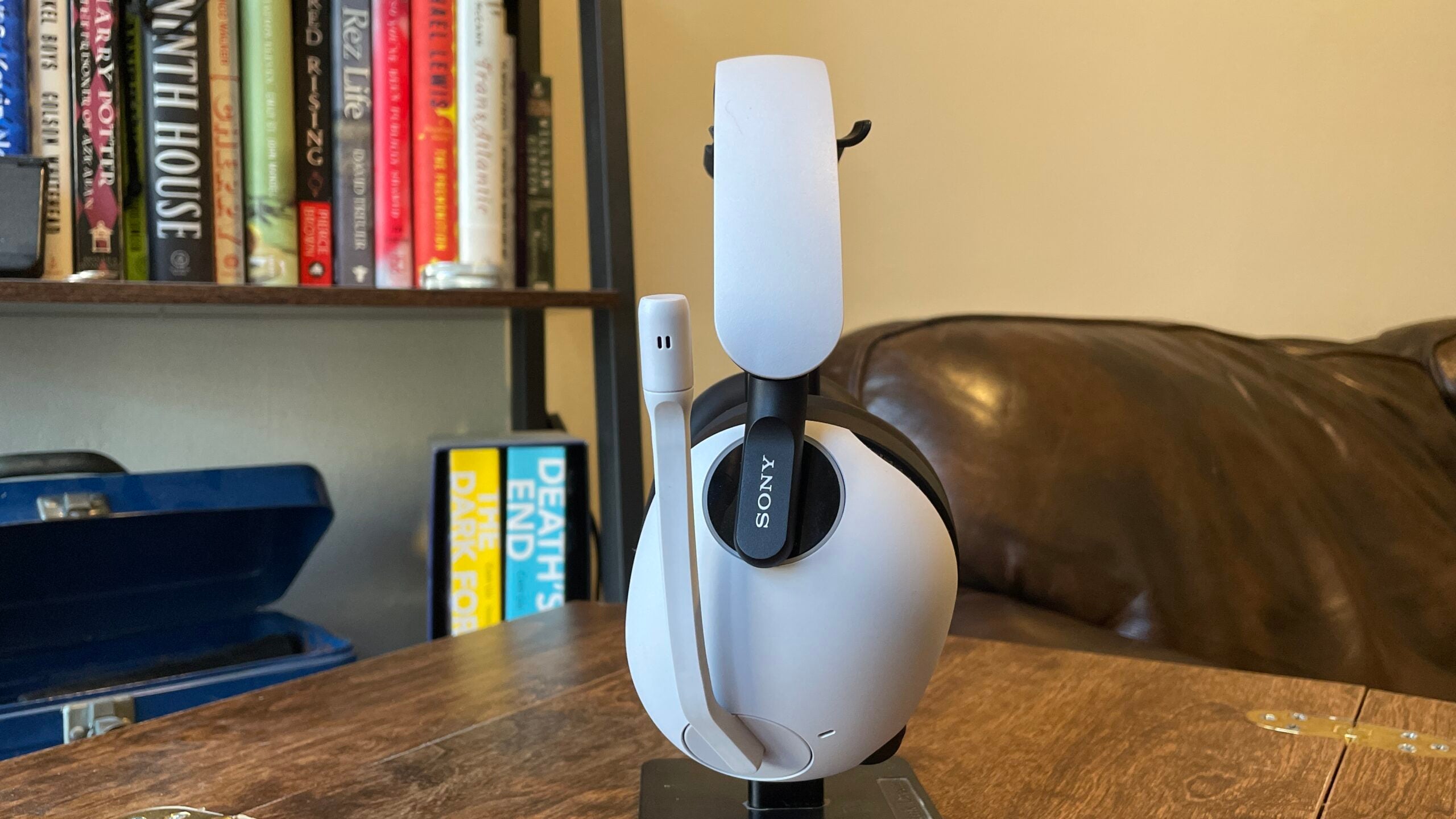 Better gear means better directional cues; in gaming, that means better results—a role a good home theater system can take over from a gaming headset. / Mike Epstein
Better gear means better directional cues; in gaming, that means better results—a role a good home theater system can take over from a gaming headset. / Mike Epstein
What about the screen?
This article is mostly concentrating on sound because what changes a TV into a home theater is the sound system. But the screen—whether TV, monitor, or projector—is hardly an afterthought. Luckily, we also have a few resources for those particular components available for you. Choosing the best screen type depends on your particular media needs and the space you want to fill. In general, monitors are going to be smaller for smaller spaces without any live television broadcasts (though an attached computer or streaming box offers plenty of content); TVs will let you enjoy more live sports and news in your local market and will likely have a lot of streaming platform applications integrated into them; and projectors are necessary for large-scale or outdoor viewing.
 A projector is necessary to stream TV and movies outside. / Roberto Nickson, Pexels
A projector is necessary to stream TV and movies outside. / Roberto Nickson, Pexels
Making a sound home-theater investment
From here, we will look at the home theater as an expanding process. First, we’re going to start with what you can do to begin your journey into having a home theater, and how you can build your system out from that point. If you’re already in the midst of putting together a home-theater system, feel free to skip ahead. But for those who need to start at the beginning—as fine a place to start as any—let’s get going.
Home theater for beginners: Basic soundbars

Easy to install, use, and a huge upgrade over built-in speakers, basic soundbars offer a super affordable first entry point into upgrading your screen into a home theater.
“Soundbar” (sometimes “sound bar” or, alternatively, “media bar”) is a generic term for a particular speaker product. These speakers are long/wide but not tall, and they’re meant to be placed directly in front of your television. Within the housing are typically five (though sometimes three) different speakers meant for different channels of sound, aligning with those from Dolby Digital encodings: right, left, center, left surround, and right surround. A dedicated woofer for extra low-end oomph is sometimes included in a soundbar but is more often a separate wired or wireless cabinet. Often, additional channels for 7.1 or Atmos sound can be possible through add-on components or are replicated virtually through software or additional technology meant to mimic more components without actually having them.
Soundbars are the smallest and cheapest option to begin your journey into the world of home-theater sound. Throwing multiple channels from a long multi-speaker enclosure, you’ll get a huge boost, even if you won’t yet feel the fear of hearing the killer in a slasher movie right behind you. Starting with a soundbar isn’t a big commitment and often can be used as the base speaker of a larger system later, allowing you to expand your system instead of replacing it if you decide to upgrade. If you live in a small apartment without the space to consider multiple large speakers (especially rear and overhead speakers), or if you’re averse to installation and calibration requirements to get the most out of multiple speakers, soundbars require none of that. It’s the closest home theaters get to ready-out-of-the-box.
Pros
Extremely affordable
Space-conscious
Huge upgrade over built-in sound from a monitor, television, or projector
Various models offer additional technologies or features that can minimize the need for multiple set-top boxes
Cons
Sound only comes from one place, meaning it won’t truly feel 3D
Individual speakers typically outshine each soundbar channel
Lower-end soundbars may not be compatible with high-end sound technologies
Recommendations
Sonos Beam (Gen. 2)—One of the best soundbars you can get under $500, Sonos Beam offers five channels and replicates Dolby Atmos by sending sounds up and around you by bouncing them off surfaces so they feel as if they’re not just coming from the bar itself. It’s not nearly as incredible as having discreet rear and/or overhead speakers, but for the price it’s a very acceptable compromise. When you want to upgrade, the Beam is a worthy center-channel sound bar and can easily pair with other Sonos products to create a full surround system.
Roku Streambar Pro—While a bit less powerful than the Sonos Beam, with only three channels here instead of five, the Roku Streambar Pro is the best budget bet. The $179 price is about as low as you get, yet the sound quality from this soundbar is fantastic for that dollar amount. The biggest bonus is the fact that the Roku Streambar Pro doubles as a set-top streaming machine, and all your streaming favorites—Netflix, Amazon Prime Video, etc.—can be accessed from within the Streambar Pro’s HDMI input, freeing up a port on your TV. The Roku Streambar Pro is also among the most portable and light (only 5.5 pounds) soundbars out there, meaning if you’re a college student often moving between dorm rooms/apartments/homes or any other kind of person in transition, set-up, break-down, and transport are a snap.
Home theater next steps: Leveled-up soundbar packages
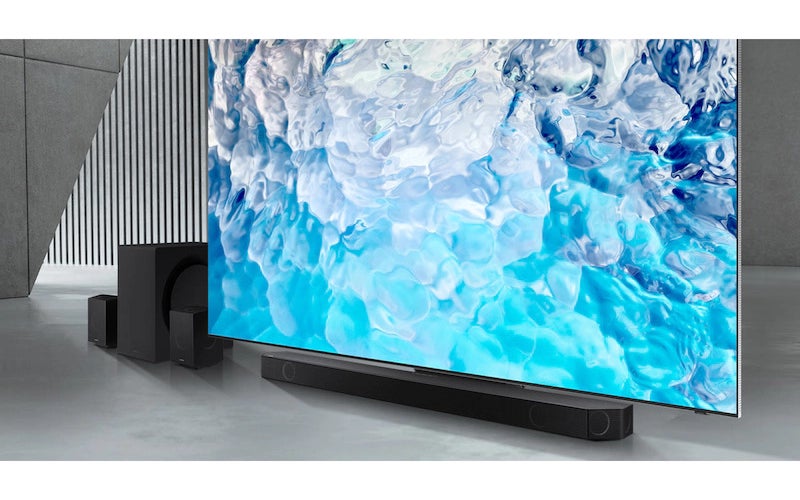
While a decent soundbar is a perfectly respectable (and often space-conscious) place to start, expanding your array of speakers while keeping the soundbar as the centerpiece allows you to slowly build out your home theater over time while retaining versatility in case your viewing space layout changes.
Many soundbar brands are sold solo and in a package system to offer a fuller soundscape to your home theater. These can be as simple as adding a subwoofer because, when it comes to theater-quality bass, there’s no replacement for displacement, or adding additional speakers for true surround sound. Most of these expanded soundbar systems keep the additional speakers just as small but powerful and easy to adjust as a soundbar does, so just having a tighter space or being more likely to move around your furniture set-up (or your household) doesn’t necessarily make these additional speakers a bad choice.
As much of an upgrade as basic all-in-one 2.0 or 2.1 soundbars are over built-in TV speaker, they still can’t give you the pinpoint directional sound experiences that make theater-going so cool. There are scenes in Top Gun: Maverick where you feel jet plane engines move across the geometry of your theater: the rumble starts in front of you and ascends during liftoff until it zooms over and behind you. Dogfights zip from left to right, giving the motion on screen even more of a you-are-there sensation. Standard soundbars will remind you of this experience but not place you back inside it. Dolby Atmos-certified systems, most often with additional components, are required for that.
The first expansion is typically a subwoofer: a speaker dedicated to bass that gives those lovely rumbles. Subwoofers are only intended as supplemental sound, and a separate subwoofer gives a lot of the “oomph” that is missing from even the nicest soundbar. Additional left and right speakers, meant to add more to the arc of sound available, are often another addition. I would argue the true game-changers are rear speakers and directional tweeters, which you place behind or around your couch/chair to allow sounds to come from as many angles as possible. Finally, overhead speakers can also be added to some systems. These can be mounted high on tripods, attached to the ceiling, or can come from specifically-designed lower speakers that aim up and bounce sound off back down from above. However, the vast majority of Atmos-enabled soundbar systems allow you to bounce sound off the ceiling rather than requiring mounted or tripod speakers.
Pros
Deep rumbling bass that enhances action movies
More precise directional sound that a movie theater offers
Audio through multiple speakers tends to be more clear and distinct than through one soundbar
Takes fuller advantage of modern sound technology such as Dolby Atmos
Cons
Escalating chance of sound bleed to neighbors if you live in an apartment
Space and placement requirements are more stringent to get the most out of multiple speakers
Cost and set-up/take-down labor are greater than a single soundbar
Recommendations
Samsung HW-Q990B—One of the best multi-speaker combo packages based around a soundbar, the HW-Q990B is Atmos-ready and can produce 11.1.4-channel sound. That means there are 11 distinct sound sources angled either at or around your seating area (center, left, right, rear left, rear right, and six surround sound speakers), one subwoofer for textured trembles, and four up-firing channels of sound that are meant to bounce off the ceiling and back toward you. The set is four total pieces: soundbar, two rear speakers, plus a wireless sub. If you want the space economy that a soundbar offers—eliminating the need for multiple speakers around your TV and an audio receiver—this package from Samsung offers literally the highest possible number of channels of sound directly from a soundbar.
Sony HT-A7000—While only sporting a 7.1.2 set-up (four less channels of surround sound and two less Atmos-style up-firing channels than the Samsung), the HT-A7000 offers the best pure sound quality among Atmos soundbar + additional speaker systems. The soundbar can be purchased alone or in a package with the rear speakers and subwoofer. The soundbar itself is one of the best stand-alone soundbars available (outside of the beastly behemoth that is the 40-pound summit-tier Sennheiser AMBEO MAX). It even features a built-in dual-channel subwoofer, allowing another space-saving choice to be made if you don’t mind the loss of powerful punch you’ll get compared to the dedicated sub. Copious connectivity is available here, including integrating the speakers into popular voice-activated smart home systems (Amazon Alexa and Google Assistant), Chromecast, Spotify Connect, and Apple Airplay. Most importantly, of all Atmos-compatible soundbars, the HT-A7000 offers the best Atmos experience, really placing sounds in their correct spot and giving that all-around sound that a home-theater experience demands.
Home-theater great leap: Component systems
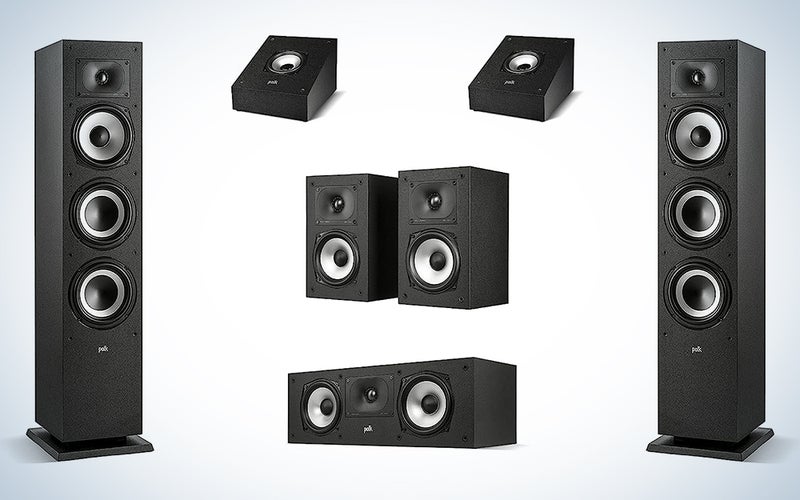
Offering power and precision that a soundbar-based system simply cannot, discrete speaker pairs/separates fed by an audio-video receiver turn casual at-home sound up to 11. The strongest, clearest, most pinpoint-precise sound can only come when you’ve got a physical place for every sound and every sound in its place.
Soundbars are popular because they require very little space and are ready out of the box. The audio-video receiver system has been around much longer, first at the center of the audiophile turntable owner’s “hi-fi” system. Later, they were ideal for videophiles who needed more inputs for multiple sources, far more than a TV offered natively. Now, even mid-market TVs come with 4-6 HDMI ports, often enough for the average consumer, making AV receivers more of a strict audiophile/cinephile piece. You will route everything into and out of these set-top boxes, including speakers, game system, Blu-ray player, television, turntable, and more. For truly ambitious audio systems—those with carefully calibrated signal chains running painstakingly angled speakers for music or in-wall architectural speakers—a powerful multi-channel receiver (or two) is a necessity. Long story short, if you want to make your room look and feel most like a home theater, you’ll probably be using an AV receiver, multiple dedicated non-soundbar speakers, and a projector. The latter two will likely be incompatible for your purposes without the former.
These systems aren’t cheap, they aren’t small, and they aren’t simple. To get the most out of a receiver-and-speaker combo for your home theater, you’re going to really have to plan. That may include adjustments to the room itself, creating speaker shelves or mounting speakers in the ceiling, and putting wires in the walls if you’re truly going all out. But even without that kind of full-room consideration, you’ll need tripods, a good media shelf or rack, and a lot of time to tweak the system. However, the results can be spectacular. A well-calibrated component speaker system run through a receiver is head-and-shoulders above a soundbar-based system. A system like this is a little less build-over-time than a soundbar system, as your receiver itself is going to have a limit to the sound it can output. For example, if you buy a system that tops out at 5.2, you won’t ever get as deep surround sound as you could. If your receiver doesn’t feature HDMI 2.1 ports, your game machine won’t be able to reach the best visual fidelity it can. This tier of sound is the best but requires the most of you. It also allows you to marry multiple inputs—turntable, television, streaming box, or game system—with more room to spare for expansion. Whether it’s worth it ultimately depends on how much you care and can spare—time, space, and money.
Pros
Hands down, the best possible sound quality, surpassing soundbar systems.
Greater quality from every sound source
Highly recommended for home “screening room” set-ups
Brings order to the chaos of a home theater set-up
Marries various audio and video machines into one system
Cons
Expensive
Expansive
Labor-intensive
Recommendations
Marantz SR6015—As far as receivers go, this is a top pick. A 9.2-channel centerpiece of your system, it sings with Atmos and its similar competitor DTS:X, even supporting virtual modes that create Atmos-esque sound regardless of the speaker set-up. So, if you can’t outfit the full 5.1.4 or 7.1.2 available, you can still get an Atmos-y experience. Multi-room systems are also possible with the built-in OS. Other than the remote lacking a backlight, it’s pretty much everything you want in a home theater receiver.
Polk Dolby Atmos Home Speaker Bundle—Polk is a strong brand for home theater audio and the company’s bundle for Atmos, paired with the Marantz receiver above, is an ideal entry system (you can certainly spend thousands more, and get even more expressive sound, if you invest in Polk Reserve floorstanding speakers, height modules, etc.). Everything you need is here: an excellent low-profile center speaker to place just below your screen, two towers for left and right of center and to provide surround sound, two bookshelf speakers for rear-channel sound, and two 3D height speakers to Atmosify the system. With the Marantz, you can even add an extra pair of towers, bookshelves, or height speakers, depending on how you want your soundscape to coalesce. And that’s just one of the many brands—from consumer favorites Klipsch to audiophile favorites Focal to innovators Definitive Audio (who put powered subwoofers in their expansive-sounding flagship bipolar floorstanders)—that have Atmos-enabled or height topper-compatible towers, etc. You can spend several hundred to many, many (many) thousands, depending on the setup.
Oh, and if you do decide on rigging up your own speaker system through a receiver, you’re going to want to check out our speaker wire recommendations (as well as our HDMI cables).
Wired vs. wireless
Beyond the basics like price and space, one of the things you’ll really have to consider when you choose to go beyond a soundbar for your home theater system is if you want to commit to a wired or wireless system. There are, of course, benefits and drawbacks to both. Wired systems are inevitably going to have higher audio fidelity. While wireless has come an incredibly long way, it still can’t carry audio information with the undiluted fidelity as a wired connection. So if pure audio bliss is your goal, wires are your friend. But they’re also a huge hassle to manage with a home theater that doesn’t sit in a dedicated, specially-designed room. A screening room can be adapted to the configuration and response desired as the space is designed, but your living room system needs a system that will adapt to the space it’s placed in. Speaker wires will need to be run up walls, covered in rubber wire casings, or otherwise hidden/corralled in order not to make the space less inviting or more dangerous for fumbling feet. If you have kids, a loose speaker wire can easily lead to a trip, fall, and broken speaker (or even worse, a kid’s bone) when they’re running around the house.
Thus, the slight loss in audio quality compared to a wired system may be a fair trade for the versatility, aesthetic improvement, and tidiness that a wireless system offers. If you do want to go wireless and you want as unadulterated a sonic experience as you can possibly get, consider the Nakamichi Shockwafe Ultra 9.2.4 eARC SSE Max. This package is absurd in the best way. Combining comprehensive inputs, 18 speaker drivers in seven housing units, compatibility with all the latest audio and video technologies (Atmos, DTS:X, eARC), and wireless connectivity to four surround speakers and dual subwoofers, it’s a really impressive package and as close to the pinnacle in terms of sound quality as you can get in a wireless surround sound system.
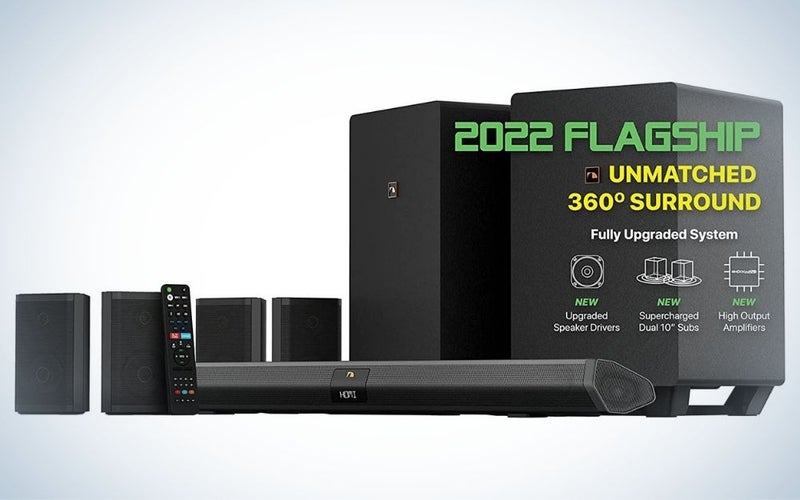
FAQs
Q: What system do I need to make my TV sound like a movie theater?
You’re going to want a minimum of a 5.1 system to start feeling like you’re in a movie theater. This means a center, left, and right channel along with two surround channels plus a subwoofer. This won’t feel exactly like the cinema, but it’s the first big leap beyond basic speakers in your television. You can achieve this with a single soundbar plus a separate sub, and if you’re not sure how deep into home theater audio you want to go, that’s a perfect place to start.
Q: What audio configuration is Dolby Atmos?
This is a tricky question, as Dolby Atmos capabilities and its actual output are two different things. The thing that makes Atmos distinctive is height channels, an innovation over Dolby Surround. Strictly speaking, the bare minimum to enable Atmos sound is 3.1.2, meaning a left, right, and center channel as the main sources of sound, with a subwoofer for bass and two Atmos-enabled speakers for surround. However, this setup will condense a lot of channels together. Typically, it’s recommended to have a seven-channel surround system, a subwoofer, and four Atmos channels (7.1.4) to avoid folding too many sound objects onto and into one another, but a truly ambitious person can go all the way up to 24.1.10 if they have the money and space for that many speakers.
Q: Which is better for gaming, a home theater or 3D headphones?
If you game with friends or people like to watch you game, I’d definitely go with the home theater. Narrative games like Resident Evil 4 or God of War Ragnarok are pretty spectacular spectator experiences with a great screen and sound system. If you’re only concerned with a good solo/online gaming experience and the competitive edge that great sound brings, however, a headset is more economical and manageable.
Q: Which is better for a home theater, a 4K TV or an 8K TV?
This is a matter of future-proofing and tiny increases in quality. As of the present, there isn’t much commercially available content in 8K. Buying a 4K Blu-ray and playing it on an 8K screen will upscale the resolution, making it look slightly better than it would on a 4K screen, but it’s not a huge enough leap in quality to justify an 8K screen on that alone. Additionally, the two high-fidelity consoles (PS5 and Xbox Series X) top out at 4K as well. However, that will change eventually; it’s inevitable. It’s at that moment that an 8K TVs’ potential will be unlocked. Strictly speaking, right now, 4K is more than enough (and already a big leap from 1080p).
Final thoughts on home-theater systems
If you’re hesitant about the world of home theater, don’t be. Even the cheapest soundbar is going to improve your viewing or playing experience, and some budget-priced options are surprisingly worthy. You can always start small and work your way up, expanding your system over time. However, I encourage you to consider what you hear when you watch as much as what you see. Home theater sound is so, so sweet. Film, television, online content, and games are a feast for the senses, and your ears deserve dessert.
Why trust us
Popular Science started writing about technology more than 150 years ago. There was no such thing as “gadget writing” when we published our first issue in 1872, but if there was, our mission to demystify the world of innovation for everyday readers means we would have been all over it. Here in the present, PopSci is fully committed to helping readers navigate the increasingly intimidating array of devices on the market right now.
Our writers and editors have combined decades of experience covering and reviewing consumer electronics. We each have our own obsessive specialties—from high-end audio to video games to cameras and beyond—but when we’re reviewing devices outside of our immediate wheelhouses, we do our best to seek out trustworthy voices and opinions to help guide people to the very best recommendations. We know we don’t know everything, but we’re excited to live through the analysis paralysis that internet shopping can spur so readers don’t have to.
>>> Read full article>>>
Copyright for syndicated content belongs to the linked Source : Popular Science – https://www.popsci.com/gear/best-home-theater-systems/






























